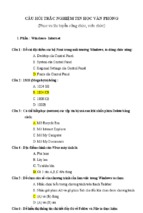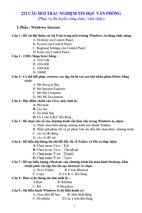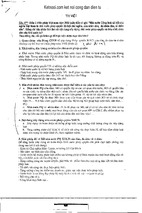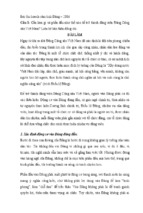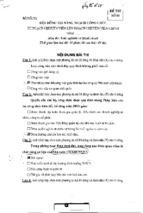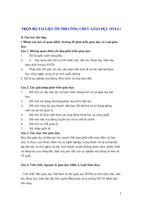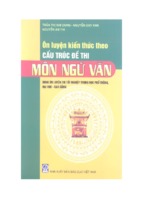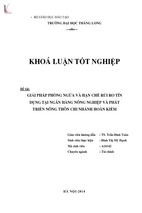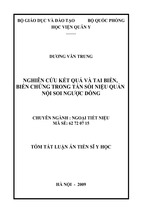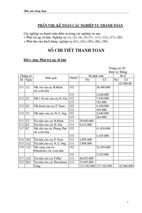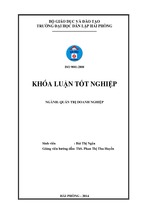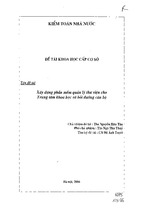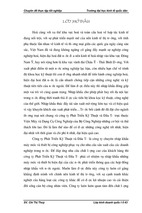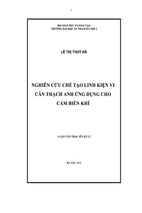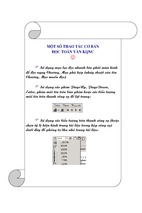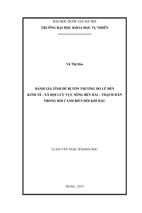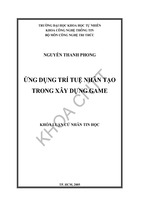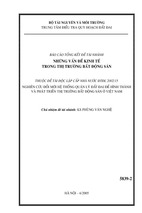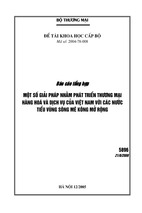NC-213
2003 ANNUAL PROGRESS REPORTS
Published: January 2004
MANAGEMENT OF GRAIN QUALITY AND
SECURITY IN WORLD MARKEETS
Officers
Chairman ..................................................................................................................Dirk Maier, Purdue University, IN
Vice Chairman...........................................................Marvin Paulsen, University of Illinois at Urbana-Champaign, IL
Secretary ......................................................................... Eluned Jones, Texas A & M University, College Station, TX
Past Chairman............................................................ Lloyd Bullerman, University of Nebraska-Lincoln, Lincoln, NE
Industry Advisory Committee Chairman.....................Jim Stitzlein, Consolidated Grain & Barge Co., New Berlin, IL
CSREES/USDA Representative...................................................Damanna Ramkishan (Ram) Rao, Washington, D.C.
Administrative Advisor/Coordinator ................ F. William Ravlin, The Ohio State University/OARDC, Wooster, OH
Administrative Associate and Report Production....... Bill Koshar, The Ohio State University/OARDC, Wooster, OH
Representatives
Participating Stations
Arkansas Agricultural Experiment Station, Fayetteville .............................................................................. Wade Yang
Illinois Agricultural Experiment Station, Urbana......................................................................................Karen Bender
Indiana Agricultural Experiment Station, (Purdue) W. Lafayette .............................................................Dirk E. Maier
Iowa Agricultural Experiment Station, Ames...........................................................................Charles R. Hurburgh, Jr.
Kansas Agricultural Experiment Station, Manhattan ......................................................................Timothy J. Herrman
Michigan Agricultural Experiment Station, East Lansing .......................................................................Perry K.W. Ng
Montana Agricultural Experiment Station, Bozeman...................................................................... Florence V. Dunkel
Nebraska Agricultural Experiment Station, Lincoln........................................................................ Lloyd B. Bullerman
North Dakota Agricultural Experiment Station, Fargo.................................................................... Charlene Wolf-Hall
Ohio Agricultural Research & Development Center, Wooster.............................................................. Richard C. Pratt
Texas Agricultural Experiment Station, College Station.................................................................... Lloyd W. Rooney
Wisconsin Agricultural Experiment Station, Madison .............................................................. Sundaram Gunasekaran
Beltsville Agricultural Research Center (BARC), Beltsville......................................................... Stephen R. Delwiche
USDA, ERS, Market and Trade Economics, Washington, D.C. ..........................................................Demcey Johnson
USDA, Grain Inspection, Packers, and Stockyard Administration, Kansas City .......................................Steve Tanner
USDA, ARS, National Center for Agricultural Utilization Research, Peoria.................................. Donald T. Wicklow
USDA, ARS, Grain Marketing and Production Research Center, Manhattan................................ Donald E. Koeltzow
USDA, ARS, Center for Medical, Agricultural and Veterinary Entomology, Gainesville..................... Terry Arbogast
i
The Industry Advisory Committee
The Andersons, Inc.............................................................................................................................. Robert Smigelski
Cargill.......................................................................................................................................................... Arvid Hawk
Consolidated Grain and Barge.................................................................................................................James Stitzlein
Foss N.A. ..................................................................................................................................................... Allen Butler
Illinois Crop Improvement .................................................................................................................... John McKinney
The Quaker Oats Company ................................................................................................................ A. Bruce Roskens
NC-213 Objective A
Determine the effects of genetic traits, abiotic environmental conditions, and handling practices
on the quality of cereals and oilseeds.
Develop a method for quantification of sphingolipids in soybeans without alteration of their chemical structure and
to provide preliminary evidence reflecting the effects of composition (variety), maturity, and environmental
conditions on sphingolipid contents of soybeans...........................................................................................................1
Determine the effect of porosity on the permeability and airflow resistance of grains. ................................................2
Examine milling properties, dough characteristics, protein functionality, and baking properties of soft white wheat
varieties..........................................................................................................................................................................4
Maintain a national database of corn/soybean yield-quality results. .............................................................................6
Evaluate physical, chemical and processing properties of sorghum and corn and develop improved food quality
cultivars, improve aflatoxin tolerance and improve nutritional and processing quality of corn through breeding, and
define the attributes of wheat flours with excellent quality for flour tortillas................................................................9
Improve corn resistance to Aspergillus flavus and aflatoxin. ......................................................................................14
Investigate the microbial ecology and epidemiology of Aspergillus flavus in Midwestern crop field soils and the
biocontrol potential of sclerotial mycoparasites. .........................................................................................................16
Determine the effect of preharvest production practices on enduse quality of wheat..................................................18
ii
NC-213 Objective B
Assess the effects of microbial growth, insect infestation and handling on quality of cereals and
oilseeds.
Examine the institutional issues raised by the Starlink™ incident and develop recommendations for developing
effective institutional mechanisms for promoting transparency in grading of genetically modified crops and examine
the historical trends of seed saving practices by farmers and implications for production, marketing and delivery of
quality cereals and oilseeds. ........................................................................................................................................19
Develop and evaluate automatic grain aeration control strategies for maintaining grain quality and controlling
insects during storage. .................................................................................................................................................21
Evaluate, under field conditions, the use of carbon dioxide detectors to monitor for bio-activity in stored corn prior
to the time that spoilage would be detected by traditional methods. Our hypothesis is that CO2 monitors can
efficiently detect grain in the early stages of spoilage. ...............................................................................................24
Screen food grade lactic acid bacteria for antifungal activity and to determine the effects on mold growth and
mycotoxin production..................................................................................................................................................26
Identify technical, social, economic, and institutional constraints that impede segregation of GM-based VE crops
and create system analysis and management tools to assist in the adoption of VE grain handling and marketing
strategies. .....................................................................................................................................................................28
Develop trapping and contour analysis of trap catch as a method for monitoring stored product insect pests in
warehouses, processing plants, and retail stores, and locating foci of infestation. .....................................................30
Study the effects of low temperatures on mortality of Indian meal moth (Plodia interpunctella), to model
temperatures inside grain bins under various management schemes, and to use this information to develop stored
grain management recommendations that will reduce problems with Indian meal moth (IMM)................................32
NC-213 Objective C
Quantify and define quality of cereals and oilseeds for various end-use markets.
Develop a non-enzymatic preparative-scale synthetic method for dityrosine and 3-bromotyrosine. ..........................35
Fourteen (14) flour blends of two natural wild type wheat (Triticum aestivum L.) flours, 'Nuplains' and 'Centura,'
blended with one waxy flour sample were characterized and processed to Asian salted noodles. ..............................37
The relationship between the protein content and quality of wheat flours and characteristics of noodle dough and
instant noodles were investigated. ...............................................................................................................................39
The ISU Grain Quality Laboratory has been creating calibrations for near-infrared (NIR) analyzers in order to
improve accuracy and functionality of near infrared instrumentation. ........................................................................41
Conduct basic and applied research in the biochemistry and technology of grain sorghum to identify and evaluate the
biochemical components that govern processing, functionality, and susceptibility to mold. The information is used
to improve sorghum quality and utilization for increasing domestic and export markets. ..........................................44
iii
Develop fast reliable methods for the identification of quality traits of wheat starches. .............................................46
Evaluate kernel characteristics, milling properties, and dough and bread-, tortilla- and Asian alkaline noodle-making
properties of hard winter wheat progenies. Determine protein and lipid contents, and composition and interaction
among these components of cereal grains as they relate to storage, handling, and end-use properties. ......................48
Develop methods to characterize cereal proteins and/or protein fractions. Develop methods to identify components
related to end-use properties........................................................................................................................................52
Investigate the role of the albumin and globulin proteins (water and salt soluble), phenolics and non-starch
carbohydrates of wheat flour on quality and functionality. .........................................................................................54
Develop methods to automatically detect and measure physical defects and morphological factors of corn and
soybean kernels that relate to quality and end-use.......................................................................................................56
Develop sensors, instrumentation, and procedures for objective grading, on-line measurement, and end-use property
assessment of single kernels or bulk samples. .............................................................................................................58
Relate soybean composition to processing value via a 20-year history of soybean composition research that was
assembled. ...................................................................................................................................................................62
Identify methods of measuring the storability of shelled corn.....................................................................................66
Determine the effects of food processing on fumonisins, moniliformin, deoxynivalenol and zearalenone. ...............69
Evaluate methods to treat Fusarium head blight (FHB) infected barley in order to prevent Fusarium growth and
mycotoxin production during malting. ........................................................................................................................71
NC-213 Objective D
Determine the economic impact of improving the quality of cereals and oilseeds.
Development of producer training and awareness materials that encourage the development of higher value grain
markets in Iowa. ..........................................................................................................................................................73
Development of quality system certification for the grain market. .............................................................................75
iv
Objective A
Determine the effects of genetic traits, abiotic
environmental conditions, and handling practices on the
quality of cereals and oilseeds.
NC-213 Objective A
Project Objectives
Develop a method for quantification of sphingolipids in soybeans without alteration of their chemical structure and
to provide preliminary evidence reflecting the effects of composition (variety), maturity, and environmental
conditions on sphingolipid contents of soybeans.
From
Iowa State University
Department of Food Science & Human Nutrition
Department of Agronomy
Georgia Institute of Technology
School of Chemistry and Biochemistry and School of Biology
By
Wang, T. (Toni)
Sullards, M. C.
Fehr, W. R.
Results for 2003
Soybean is believed to be a relatively rich source of sphingolipids, which are a class of polar lipids with desirable
biological activities. However, analytical methods for sphingolipids vary, and quantitative data is scarce. The
objectives of this study were to develop a method for quantification of sphingolipids in soybeans without alteration
of their chemical structure and to provide preliminary evidence reflecting the effects of composition (variety),
maturity, and environmental conditions on sphingolipid contents of soybeans. Separation of neutral lipids and
interfering polar lipids from sphingolipids by saponification, transesterification, and solvent partition was studied.
Solvent partition and TLC purification was identified to be the most accurate sample preparation method for HPLC
quantification. This study showed that cerobroside concentrations among soybeans with different compositions
(variety), maturities and growing conditions ranged from 142 to 493 nmol/g seed dry-weight-basis, and the Edmame
seeds contained about twice as much cerobroside as in the mature seeds. However, the composition of molecular
species of cerobroside was relatively unchanged.
1
NC-213 Objective A
Project Objectives
To determine the effect of porosity on the permeability and airflow resistance of grains.
From
University of Kentucky
Biosystems and Agricultural Engineering Department
Purdue University
Agricultural and Biological Engineering Department
By
Montross, M.D.
McNeill, S.G.
Maier, D.E.
Results for 2003
Permeability is an important material property in determining the magnitude of natural convection currents during
periods of non-aerated storage. The permeability of corn, soybeans, soft white wheat and soft red wheat was
measured as a function of bulk density and moisture content. Air was passed through a column of grain and the
flow rate and pressure drop measured. Bulk density and kernel density were also measured to determine the
porosity of the grain in the test column. A dense filling method increased the bulk density by approximately 50
kg/m3, a maximum increase of 7%. This resulted in a reduction in the porosity of approximately 4 percentage
points. However, the permeability decreased by a maximum of 45%. Wheat had the lowest permeability (between
1.15x10-8 and 7.29x10-9 m2 depending on bulk density and moisture content) and corn and soybeans were similar
and varied between 1.30x10-8 and 3.03x10-8 m2. Experiments were conducted up to a velocity of 0.0052 m/s that
resulted in a Reynolds number of 2.5, which is above the maximum expected during non-aerated grain storage.
Nevertheless, Darcy's law is appropriate to predict natural convection currents during non-aerated storage.
Airflow resistance of corn, red wheat, white wheat, and soybeans was determined using Ergun’s equation. Previous
work had indicated that Ergun’s equation would not be applicable to grain aeration due to packing effects within the
bin. However, research has indicated that packing can be estimated using granular mechanics models and changes
in porosity of grain bulks could be estimated. The overall error using Ergun’s equation was less than 10 Pa/m, when
the pressure drop was less than 250 Pa/m. If all data was included up to a pressure drop of 1,000 Pa/m the standard
error averaged 40 Pa/m. The effect of grain orientation that would be typical in storage bins was negligible. With
grain orientations that varied between perpendicular and 20° greater than the angle of repose, the change in pressure
drop was negligible.
Plans for (2004
Duct work will be placed in model bins and a finite element model of non-uniform airflow distribution validated.
Non-uniform airflow distribution will be integrated into a model of heat and mass transfer within stored grain.
Based on these results the system will be investigated at some farms and elevators.
2
Publications
Molenda, M., M.D. Montross, S.G. McNeill, and J. Horabik. Airflow resistance of seeds at different bulk densities.
Paper No. 03-6009. ASAE International Meeting. Las Vegas, NV. July 27-30, 2003.
Issues
Current models of airflow resistance do not adequately predict the pressure drop in deep bins. This is primarily due
to the overburden pressure of the grain in the bin and the decrease in the porosity of the grain bulk.
What Was Done
The airflow resistance and permeability of corn, soybeans, white wheat, and red wheat were tested at three moisture
content levels and two packing levels.
Impacts
Traditionally airflow resistance has been predicted using Shedd’s equations. However, the equations do not
accurately predict airflow resistance in deep bins. Combining models of packing and airflow resistance would allow
for the determination of airflow resistance in deep bins.
3
NC-213 Objective A
Project Objectives
Examine milling properties, dough characteristics, protein functionality, and baking properties of soft white wheat
varieties.
From
Michigan State University
Department of Food Science & Human Nutrition
By
Ng, Perry K.W.
Results for 2003
We have continued to examine soft wheat varieties for milling and baking qualities. Biochemical studies on flour
proteins were conducted. There was a wide range of protein quality among the examined flour samples. The use of
transglutaminase (TG) to improve dough strength of weak gluten protein flour samples was investigated. The
incorporation of TG allowed soft wheat flour to make satisfactory pan bread. Results revealed that TG has more
beneficial effects on weaker protein flour than strong protein flour samples. Furthermore, when TG was
incorporated in frozen dough samples, the freezing effects on dough samples were reduced. The biochemistry of the
cross-links formed among flour proteins via TG is being examined.
Plans for 2004
Our plans are to continue evaluating intrinsic quality parameters for soft wheat varieties for milling and baking
characteristics, to continue identifying possible biochemical markers for these characteristics, and to publish
available data. In addition, biochemistry of TG in dough will be further examined.
Publications
Ng, P.K.W., Ward, R., Tanhehco, E. MSU Wheat Quality Testing Program: Report on Milling and Baking Test
Results for Selected Michigan-Grown Soft Wheats Harvested in 2001. January 2003. 37 pp.
Mujoo, R. and Ng, P.K.W. 2003. Physicochemical Properties of Bread Baked from Flour Blended with Immature
Wheat Meal Rich in Fructooligosaccharides. J. of Food Sci. 68:2448-2452.
Basman, A., Koksel, H., and Ng, P.K.W. 2003. Utilization of Transglutaminase to Increase the Level of Barley and
Soy Flour Incorporation in Wheat Flour Breads. J. of Food Sci. 68:2453-2460.
Mujoo, R. and Ng, P.K.W. 2003. Identification of wheat protein components involved in polymer formation upon
incubation with transglutaminase. Cereal Chem. 80:703-706.
Khan, K., Nygard, G., Pogna, N.E., Redaelli, R., Ng, P.K.W., Fido, R.J., and Shewry, P.R. 2003. Electrophoresis of
Wheat Gluten Proteins. Pages 31-59. In Wheat Gluten Protein Analysis. Ed. by P.R. Shewry and G.L.
Lookhart. AACC, St. Paul, MN.
Basman, A., Koksel, H., and Ng, P.K.W. 2003. Utilization of rapid visco analyzer for assessing the effect of different
levels of transglutaminase on gluten quality. In Proceedings of Gluten 2003, Universita degli Studi della
Tuscia, Viterbo, Italy.
4
Otani, M., Rujoo, R., and Ng, P.K.W. 2003. Effect of wheat-koji on baking quality of bread. AACC Annual Meeting
Program Book.
Gazza, L., Niglio, A., Pogna, N., and Ng, P.K.W. 2003. Allele composition at the Pina-D1 locus coding for
puroindoline an in bread wheat. AACC Annual Meeting Program Book.
Otain, M., Mujoo, and Ng, P.K.W. 2003. Modification of wheat proteins by transglutaminase in bread doughs
during frozen storage. AACC Annual Meeting Program Book.
What Was Done
Samples were obtained from the Michigan State University Wheat Quality Testing Program, from various breeding
programs in the country, and from some commercial wheat flour samples. Experimental analyses were carried out either
according to AACC official methods or following published procedures. Partial results were presented at the Michigan
State Miller’s Association Annual Meeting and the AACC Annual Meeting, and published in refereed journals.
Impacts
This project will result in a better understanding of wheat flour quality in relation to end-use products. In addition, the
use of TG will potentially allow (1) bakers to use weaker flour to produce satisfactory baked products, and (2) millers to
provide more consistent flour quality to bakers in spite of environmental growing factors.
5
NC-213 Objective A – Procedure 1a
Project Objectives
Maintain national database of corn/soybean yield-quality results.
From
Iowa State University
Department of Agricultural Engineering
By
Brumm, T.J.
Hurburgh, C.R., Jr.
Results for 2003
U.S. soybean producers, representing 30 soybean production states, in response to a mailed request, provided 1204
samples of 2003 crop soybeans for analysis. Samples were analyzed for protein and oil contents using an Infratec
near-infrared instrument (Foss North America, Eden Prairie, Minn.). A geographically distributed subset was sent to
the University of Missouri for amino acid analysis. From other sources, data on the yield and physical quality (U.S.
Grade factors) of U.S. soybeans have been collected. Data were organized by state and region (groups of states).
Weather data for the 2003 growing season were collected to demonstrate the impact of unusual environment
(drought in Midwest) on soybean composition. From other sources with measured crop yield, approximately 2500
soybean plot samples were also analyzed.
Composition data are given in Table 1. Average U.S. protein and oil contents for 2003 were 35.65% and 18.66%
respectively (on a 13% moisture basis). These are slightly above the long-term U.S. averages of 35.42 % protein
and 18.60 % oil. The soybeans from the 2003 crop will produce, on average, 43.8 lbs of 48% protein meal and 10.9
lbs of oil per bushel at 13% moisture. If the soybeans were at 11% moisture, they would yield an average of 44.8
lbs of 48% protein meal and 11.2 lbs of oil per bushel.
The variability (standard deviation) within states, regions, and the U.S. was substantially higher than in 2002. This
means that regional or other forms of geographic buying for higher protein and oil will yield more uncertain results.
The higher variability was particularly pronounced in the oil, with a standard deviation of 1.02 percentage points as
compared to an 18-year average of 0.89 percentage points.
The north to south protein pattern (lower north, higher south) was present, but was not consistent. For example,
Minnesota soybeans were very close to the national averages in protein and higher in oil. This is very unusual; it
has happened only one other time (1991). Likewise, Midsouth soybeans were lower in protein than those in the
Eastern Corn Belt. Harvest temperatures were at or above average throughout harvest, so there should be little frost
damaged soybeans which cause oil refining problems. Expect moistures under 12% this year, below the historical
average. Soybeans will be small, which may require resetting of cracking rolls and other equipment to prevent
abnormal oil loss into meal. This was the 19th year of the survey. Figure 1 demonstrates that there has been
virtually no change in soybean quality over that period despite steady yield increases.
6
Table 1. United Soybean Board/American Soybean Association 2003 Soybean Quality Survey Data.
Number of
Samples
Protein
Percent
Std.
Average
dev.
Oil
Region
State
Western
Corn
Belt
(WCB)
Iowa
Kansas
Minnesota
Missouri
Nebraska
North Dakota
South Dakota
268
30
104
67
105
30
58
35.82
35.48
35.66
34.75
34.31
35.13
34.88
Averages
Ranges
Western Corn Belt
Western Corn Belt
662
35.32
1.67
(26.2 - 41.8)
18.86
0.93
(15.1 - 21.6)
Eastern
Corn
Belt
(ECB)
Illinois
Indiana
Michigan
Ohio
Wisconsin
234
110
38
84
38
35.55
36.12
36.57
36.76
36.21
18.75
18.29
17.83
17.73
18.25
Averages
Ranges
Eastern Corn Belt
Eastern Corn Belt
504
36.00
1.57
(31.2 - 42.0)
18.37
1.02
(15.2 - 21.0)
Midsouth
(MDS)
Arkansas
Kentucky
Louisiana
Mississippi
Oklahoma
Tennessee
Texas
46
12
6
24
1
10
4
36.15
34.94
36.28
35.64
36.90
35.87
34.05
18.76
19.05
19.40
19.36
16.80
19.12
19.85
Averages
Ranges
Midsouth
Midsouth
103
35.80
1.56
(30.9 - 40.1)
19.03
1.15
(16.8 - 22.5)
Southeast
(SE)
Alabama
Florida
Georgia
North Carolina
South Carolina
3
0
1
8
2
36.70
2.37
17.90
1.17
–
–
–
–
–
–
Averages
Ranges
Southeast
Southeast
14
36.26
1.44
(34.5 - 39.2)
18.50
0.95
(16.6 - 20.7)
East
Coast
(EC)
Delaware
Maryland
New Jersey
New York
Pennsylvania
Virginia
2
6
4
7
4
2
36.80
36.18
36.53
36.96
36.50
37.05
18.20
18.12
18.33
17.31
17.38
17.90
Averages
Ranges
East Coast
East Coast
25
36.62
1.41
(33.3 - 40.5)
17.80
0.91
(15.6 - 19.9)
USA
Averages
Ranges
US 1986-2003 avg.
1308
35.65
1.65
(26.2 - 42.0)
35.41
18.66
1.02
(15.1 - 22.5)
18.60
36.30
36.16
36.05
Basis 13% moisture
Data as of November 7, 2003
7
1.41
2.10
1.60
2.17
1.10
1.98
1.62
1.60
1.42
1.33
1.38
1.62
1.39
1.67
1.57
1.81
–
1.15
0.61
1.45
0.49
1.41
1.57
1.11
1.86
1.35
0.92
Percent
Average
Std.
dev.
18.69
18.76
19.04
19.09
19.24
18.81
18.49
0.85
1.29
0.85
1.09
0.82
0.94
0.93
19.00
18.59
18.85
1.00
0.86
0.86
0.84
1.02
1.01
1.05
0.52
1.41
–
1.07
1.20
0.96
0.92
0.42
0.99
0.73
1.02
0.87
0.42
Yield, Protein and Oil @ 13% M
Figure 2. Historical Summary of Yield and Quality Data for U.S. Soybeans
45
Yield
40
35
30
25
20
15
1985
1990
1995
Yield (bu/a)
Protein (%)
2000
2005
Oil (%)
The yield-quality plot data demonstrated no correlation between grain yield and quality of commonly planted
soybean varieties at a plot location. As part of a United Soybean Board project, this data is presently being analyzed
for patterns that could be exploited in pricing and marketing programs.
Plans for 2004
Continue the survey. Use the long-term database for strategic planning of incentive and breeding programs. This
work will now be reported in Objective 1 of the 2003-2008 NC 213 project. Only the database development will be
reported as an NC213 contribution from Iowa State.
Publications
Brumm, T.J. and C. R. Hurburgh, Jr. 2003. Quality of the 2003 US Soybean Crop. American Soybean Association
Asia Quality Seminar Tour. November 15-22, 2003. Tokyo, Seoul, Taipei, Beijing, Shanghai, Dalien.
Issues
International buyers request protein and oil content of new crop soybeans.
What Was Done
US soybean producers provided samples for analysis. Data was presented at six seminars in Asia.
Impacts
Customers were generally satisfied with US soybean quality, although there will be some reduction in oil content
from 2002, an abnormally high oil year. Individual countries asked for quite different emphasis in quality
improvement (one asked for higher protein, one for higher total of protein and oil, and one for higher oil with
control of protein loss).
8
NC-213 Objective A – Procedure 1a
Project Objectives
Evaluate physical, chemical and processing properties of sorghum and corn and develop improved food quality
cultivars.
Improve aflatoxin tolerance and improve nutritional and processing quality of corn through breeding.
Define the attributes of wheat flours with excellent quality for flour tortillas.
From
Texas A & M University
Soil and Crop Sciences Department
By
Rooney, L.W.
Betran, J.
Waniska, R.D.
Jones, E.
Results for 2003
Sorghum Nutraceuticals. The procyanidins or tannins of special sorghums have high levels of antioxidants as
measured by several in vitro methods including the Oxygen Radical Absorbance Capacity (ORAC), DPPH, and
ABTS methods. The antioxidants are concentrated in the pericarp and pigmented testa which can be removed by
abrasive milling. The bran has a dark brown color with high insoluble dietary fiber and ORAC levels much higher
than blueberries.
HPLC was used to analyze the oligomers of tannins in sorghum and processed sorghums. The levels of monomers
and dimmers were increased by extrusion of sorghum bran while the high molecular weight polymers decreased
indicating that the higher molecular weight polymers were altered. Baking, moist cooking and other methods did
not cause similar changes. This may indicate that high friction extrusion can improve the availability of these higher
molecular weight polymers. The extrudates could be used in healthy snacks and other products.
A blend containing high antioxidant levels and insoluble fiber from sorghum bran, soluble dietary fiber from barley
and omega-3 fatty acids from flax seed produced bread with a natural brown crumb color and excellent taste and
texture. A bread mix containing these ingredients plus vital wheat gluten produces excellent bread.
Food Sorghum. New white and red tan plant hybrids with promising properties were identified in sorghum hybrid
trials grown across the sorghum belt. Several new earlier maturity food hybrids are nearing commercial reality.
Late and intermediate maturity food type hybrids are competitive in grain yields with feed grain hybrids. A few
producers are marketing identify preserved sorghums for food and interest continues.
Whole sorghum snacks were produced by low cost short barrel friction extrusion. They have excellent properties
and can be flavored with mild to strong seasonings. The hybrids used are derived from ATx631XRTx436 released
from TAES several years ago. Market development in Asia and Mexico by the US Grains Council with assistance
from this project continues.
Sorghum Mold Prevention. Sorghums that retain higher levels of antifungal proteins (chitinase and sormatin) in
their caryopses from physiological maturity to combine harvest have improved grain mold resistance. It is clear that
antifungal proteins prevent mold damage in some cultivars but they are ineffective in other cultivars. Thus, a
9
combination of factors affect mold resistance in sorghum including kernel hardness, presence of unknown inhibitors
to molds in some grains, plant characteristics and other factors.
Corn Tortillas. Staling of corn tortillas made with dry masa flour was reduced the most by use of specific
maltogenic amylases in combination with CMC and guar. Experiments with fresh masa tortillas indicated that
significantly lower levels of enzymes were required. The fresh masa was more susceptible to enzymes since it has
not been dried and rehydrated. Tortillas with significantly improved texture can be made by proper combinations of
enzymes and hydrocolloids.
Corn Quality. Progress has been made to develop corn lines with improved resistance to aflatoxin. Inbred lines and
their hybrids were evaluated under inoculation in three locations in South and Central Texas. The most promising
inbreds for reducing the risk of aflatoxins under Texas growing conditions are CML269, CML176, CML78, and
Tx807 for white grains and TxX69’s, CML323, Tx772, and CML288 for yellow grain. Most of these inbreds have
subtropical or tropical origin with hard grain.
Quality protein maize (QPM) inbreds released by the corn improvement program has good food processing
properties and higher lysine and tryptophan content. The alkaline cooking properties of several QPM hybrids were
excellent and comparable to the best quality food corns. There are differences in cooking times and pericarp
removal among the different QPM hybrids.
Flour Tortillas. In collaboration with the US Grain Marketing Lab in Manhattan, KS, a small-scale baking
procedure to evaluate wheat cultivars for tortilla quality was devised and correlated with a pilot-scale hot-press
tortilla procedure. The small scale test is being applied to wheat cultivar evaluation.
Flours with good bread baking properties usually do not produce good tortillas. Some combination of protein quality
and content characterizes the properties of wheat flours that produce excellent tortillas.
The utilization of selected protein isolates significantly improved the performance of flours that produce tortillas
with short shelf stabilities and large diameters. The combination of protein isolates gives these weaker flours the
ability to produce tortillas with optimum attributes.
Plans for 2003
Objective 2
Evaluate factors affecting processing quality of corn and sorghum. Evaluate the levels of proanthocyanidins and
other antioxidants in special sorghum cultivars with different genetics.
Determine what happens to
proanthocyanidins during friction type extrusion.
Continue efforts to develop aflatoxin resistant corn hybrids. Determine factors affecting the staling of flour and corn
tortillas. Evaluate wheat flours and other ingredients for tortilla quality.
Publications
Chapters
Rooney, L.W. and Serna-Saldivar, S.O. 2003. Food use of whole corn and dry-milled fractions. In: Corn
Chemistry and Technology. White, P.J. and Johnson, Lawrence A. (eds.), American Association of Cereal
Chemists, St. Paul, MN, pp. 495-535.
Rooney, L.W. and Serna-Saldivar, S.O. 2003. Sorghum. In: Encyclopedia of Food Sciences and Nutrition, 2nd ed.
(B. Caballero, LC Trugo, PM Finglas, eds.) Volume 8, pp 5370-5375. London: Academic Press.
10
Serna Saldivar, S.O., and Rooney, L.W. 2003. Tortillas. In: Encyclopedia of Food Sciences and Nutrition. Second
Edition. B. Caballero, L. Trugo and P. Finglas (eds.) Academic Press, London, UK. ISBN 0-12-227055-X
pp. 5808-5813.
Refereed Journal Articles
Earp, C.F., McDonough, C.M., Awika, Joseph M. and Rooney, L.W. 2004. Microscopic changes during
development of sorghums with and without pigmented testa. J. Cereal Sci. (in press)
Earp, C.F., McDonough, C.M., Rooney, L.W., 2004. Microscopy of pericarp development in the caryopsis of
Sorghum bicolor (L.) Moench. J. Cereal Sci. (in press)
Awika, J.M., Dykes, L., Gu, L., Rooney, L.W., and Prior, R.L. 2003. Processing of sorghum (Sorghum bicolor)
and sorghum products alters procyanidin oligomer and polymer distribution and content. J. Agric. Food
Chem. 51:5516-5521.
Awika, J.M., Rooney, L.W., Wu, X., Prior, R.L., Cisneros-Zevallos, L. 2003. Screening methods to measure
antioxidant activity of sorghum and sorghum products. J. Agric. Food Chem. 51:6657-6662.
Bejosano, F.P., Rooney, W.L., Klein, R.R., Rooney, L.W. and Waniska, R.D. 2003. Antifungal proteins in
commercial hybrids and elite sorghums. J. Ag. and Food Chem. 51:5911-5915.
Betran, F.J., D. Beck, M. Bänziger, G. Edmeades. 2003. Genetic analysis of inbred and hybrid grain yield under
stress and non-stress environments in tropical maize. Crop Sci 43:807-817.
Betrán, F.J., D. Beck, G. Edmeades, M. Bänziger. 2003. Secondary Traits in Parental Inbreds and Hybrids under
Stress and Non-stress Environments in Tropical Maize. Field Crops Research 83: 51-65.
Betrán, F.J., A. Bockholt, F. Fojt III, G. Odvody. 2003. Registration of Tx807 Maize Parental Line. Crop Sci. 43:
1892-1893.
Betrán, F.J., A. Bockholt, F. Fojt III, L. Rooney. 2003. Registration of Tx811 Maize Parental Line. Crop Sci. 43:
1893-1894.
Betrán, F.J., A. Bockholt, F. Fojt III, R. Waniska. 2003. Registration of Tx802 Maize Parental Line. Crop Sci. 43:
1891-1892.
Betrán, F.J., J.M. Ribaut, D. Beck, and D. Gonzalez de Leon. 2003. Genetic diversity, specific combining ability and
heterosis in tropical maize under stress and non-stress environments. Crop Sci. 43:797-806.
Bhatnagar, S., F.J. Betrán, and D. Transue. 2003. Agronomic performance, aflatoxin accumulation and protein
quality of subtropical and tropical QPM hybrids in southern USA. Maydica 48: 113-124.
Hugo, Leda F., Lloyd W. Rooney, and John R. N. Taylor. 2003. Fermented sorghum as a functional ingredient in
composite breads. Cereal Chem. 80(5):495-499.
Rooney, W.L., Miller, F.R., Rooney, L.W. 2003. Registration of RTx437 Sorghum Parental Line. Crop Science
43:445-446.
Thesis
Acosta, David. December 2003. White food-type sorghum in direct-expansion extrusion applications. MS Thesis.
Texas A&M University, College Station, TX. 120 pp.
Leal Diaz, Ana. 2003. December 2003. Food quality and properties of quality protein maize. MS Thesis. Texas
A& M University, College Station, TX. 150 pp.
11
Silva, Laura. August 2003. Effects of barley flour and beta-glucans in corn tortillas. MS Thesis. Texas A&M
University, College Station, TX. 98 pp.
Awika, Joseph. May 2003. Antioxidant properties of sorghum. PhD Dissertation. Texas A&M University, College
Station, Texas. 118 pp.
Bueso, Javier. May 2003. Staling of corn tortillas. PhD Dissertation. Texas A&M University, College Station,
Texas. 104 pp.
Maranphal, Nitit. May 2003. Direct expanded snacks from sorghum. MS Thesis. Texas A&M University, College
Station, Texas. 65 pp.
Rudiger, Crystal. May 2003. The formulation of a nutraceutical bread mix using sorghum, barley, and flaxseed.
MS Thesis. Texas A&M University, College Station, Texas. 97 pp.
Conference or Symposium Proceedings
Acosta, D., Riaz, M., Waniska, R.D. and Rooney, L.W. 2003. Decortication level and particle size effects on
extrudates made from a food-type white sorghum. In J. A. Dahlberg et al. (eds.) Proc. 23rd Biennial Grain
Sorghum Res. and Util. Conf., Feb. 16-18, 2003, Albuquerque, New Mexico. pp. 119-127.
Betrán, F.J., Tom Isakeit, Gary Odvody, Kerry Mayfield. 2003. Identification, development and characterization of
corn germplasm to reduce aflatoxin contamination. Aflatoxin/Fumonisin Workshop 2003, October 13-15,
2003, Savannah, GE.
Kerry Mayfield, Bryan Jones, Leslie Lutz, Adam Blackwelder, T. Isakeit, Gary Odvody, and Javier Betrán. 2003.
Aflatoxin accumulation in maize inbreds and hybrids. Aflatoxin & Fumonisin Workshop 2003, October 1315, 2003, Savannah, GE.
Issues
Sorghum quality for food is alleged to be inferior and sorghum is used only as livestock feed in the Western
Hemisphere. Improved sorghum food quality must be to capture food and ingredient markets.
Corn quality for alkaline cooking and tortilla staling. Fresh corn tortillas have excellent taste and texture but many
consumers have never tasted a fresh tortilla. Methods to maintain texture and taste during storage are needed.
What Was Done
New sorghum hybrids with significantly improved food characteristics were developed by incorporation of genetic
material from the world collection. We devised methods to evaluate sorghum milling and food properties that were
used to select food types of sorghum. Marketing of food sorghums is currently expanding.
Special sorghums contain high levels of antioxidants equivalent to or better than blueberries. The bran contains 3-5
times more antioxidants.
New methods to measure texture and other changes during staling of tortillas were devised. These methods were
applied to determine factors affecting staling of corn and flour tortillas.
12
Impacts
The new sorghums are being grown by some producers who have received from 10 to 25 cents per bushel more for
the grain. The high yields under limited irrigation combined with slightly higher grain prices have encouraged
producers to plant food sorghums. A source of good quality sorghum is available for use in food and feed products.
Information and grain samples were supplied to potential Japanese food processors by US Grains Council. L.
Rooney provided technical assistance in Japan and Mexico. Increased markets for food sorghum are possible.
The understanding of what happens during staling will lead to improved flavor and texture of tortillas which could
significantly increase their consumption since they are low in fat and contain significant levels of calcium and fiber.
A combination of maltogenic amylases and hydrocolloids give tortillas longer shelf life in terms of rollability.
13
NC-213 Objective A - Procedure 1a
Project Objectives
Improve corn resistance to Aspergillus flavus and aflatoxin.
From
National Center for Agricultural Utilization Research
USDA, Agricultural Research Service
Peoria, Illinois
By
Wicklow, D.T.
Kendra, D.
Muhitch, M.
Results for 2003
The aflatoxin and fumonisin in grain at harvest is found concentrated at high levels in relatively few corn kernels
and our research seeks to accurately identify and remove these toxin-contaminated kernels from contaminated grain
lots. An ARS Scientist in Manhattan, KS, in collaboration with an ARS scientist in Peoria, IL, obtained near
infrared spectra for corn kernels infected by the mycotoxin producers A. flavus and F. verticillioides, making it
possible to correctly classify infected kernels contaminated with mycotoxins. These spectra were applied
successfully in programming a high volume commercial optical grain sorter to reject aflatoxin- and fumonisincontaminated kernels in combine harvested 2002 corn grown in Eastern Kansas and Central Illinois to produce an
'accepted grain lot' conforming to FDA guidelines for use in human food.
Plans for 2004
Evaluate the spectral properties of symptomatic and asymptomatic grains from commercially grown and harvested
white corn grown in Illinois, Kentucky and Texas in order to optimize sorting of mycotoxin contaminated white
corn. Classify symptomatic and asymptomatic grains from wound-inoculated ears of corn varieties with
demonstrated resistance or susceptibility to A flavus kernel rot and/or aflatoxin in 2002 variety trials performed by a
corn seed producing company. We seek to determine if the near infrared spectra used in detecting aflatoxin and
fumonisin contaminated grains of FS 7111 and Pioneer 3394 will prove equally effective in evaluating grains over a
diverse genetic background. Determine if spectra can be applied to classify ‘resistant’ vs ‘susceptibile’
asymptomatic grains across genotypes. This collaborative research involves corn pathologists at a seed producing
company and T. Pearson, GMPRC, ARS, Manhattan, KS. Isolate and characterize antifungal proteins produced by
fungi shown to interfere with A. flavus and F. verticillioides infection of individual kernels and therefore are adapted
to function effectively in maturing corn kernels.
Issues
In the Midwestern corn belt, the bulk of the U.S. corn crop is at risk during sporadic outbreaks of aflatoxin
contamination of preharvest corn (Zea mays L.). Aflatoxin is a metabolite produced by the fungus Aspergillus
flavus. The overall goal of this research program is to attempt to control A. flavus infection of pre-harvest corn
through an integrated approach to disease management. This project investigates corn resistance factors that impact
kernel susceptibility to A flavus infection and aflatoxin, examines the role of corn endophytes F. verticillioides and
A. zeae as confounding variables in corn variety trials for aflatoxin resistance, assesses differential expression of
genes for their role in fungal / fungal and fungal / host plant interactions; discovers novel metabolites and proteins
with antifungal activity against Aspergillus and Fusarium, and attempts transgene integration and expression of
antifungal genes within the grain pedicel (rachilla), the primary route of A. flavus and F. verticillioides infection.
14
The co-occurrence of fumonisin with aflatoxin in the diet significantly increased the incidence of liver cancer in
rainbow trout (Carlson et al., 2001. Toxicol. Appl.Pharmacol. 172: 29-36)). Therefore, we also seek to
simultaneously eliminate both aflatoxin- and fumonisin-contaminated grains in a single pass through a commercial
optical sorter. Procedure 1a evaluates corn genotypes for resistance to kernel infection and aflatoxin.
What Was Done
A high speed bi-chromatic sorter was tested for removing corn contaminated in the field with aflatoxin and
fumonisin. Single kernel reflectance spectra were analyzed to select the optimal pair of optical filters to detect
mycotoxin contaminated corn during high speed sorting. These spectra were applied successfully in programming a
high volume commercial optical grain sorter to reject aflatoxin- and fumonisin- contaminated kernels in
commercially harvested grain from Kansas and Illinois.
Impacts
Over 90% of corn samples having an initial aflatoxin level between 20 and 100 ppb, and fumonisin between 4 and
100 ppm, were reduced to levels below the FDA’s recommendation for these mycotoxins by removing
approximately 5% of the incoming grain.
15
- Xem thêm -


